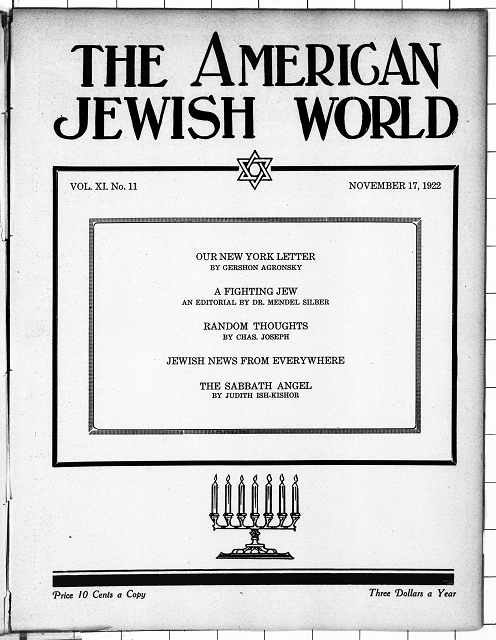The American Jewish World
American Jewish world (Minneapolis, Minn.; St. Paul, Minn.) 1915-1923 Browse the title
American Jewish world (Minneapolis, Minn.; St. Paul, Minn.) 1924-current Browse the title
Issues from this title can only be accessed from the Gale Family Library at the Minnesota History Center.
Samuel N. Deinard, publisher of American Jewish World, made no bones about his convictions and sympathies. Deinard, a prominent Minneapolis rabbi, was a staunch supporter of the creation of a Jewish homeland in Palestine. The weekly publication he founded in Minneapolis in 1915, and which was still being published as of 2019, was conceived as a means of promoting Zionism and uniting Minnesota Jews behind the cause.

Deinard started the news magazine the Jewish Weekly in 1912; it folded after six months, but he doggedly persisted, relaunching the publication as American Jewish World in 1915. The World declared itself “A Weekly Journal of Modern Jewish Life and Labors,” devoted to covering news and events concerning Jews living in Minneapolis and St. Paul. In its early years the magazine ran 16 pages, laid out over three columns. The World maintained editorial offices in the downtowns of both cities.
In its first issue of July, 30, 1915 Deinard wrote that the magazine would be “Jewish in the broadest sense of the word. Nothing of Jewish interest will be foreign to it; nothing of interest to any Jewish section, to the adherents of any Jewish movement.” In Minnesota and nationwide, Jews in the early 20th Century were split along theological and ethnic lines. Jews who had immigrated to the U.S. from Germany and other nearby countries beginning in the 1850s had little in common with Eastern European Jews who arrived later. The two groups lived in separate neighborhoods and attended their own synagogues (the majority of German Jews belonged to the Reform denomination, while most Eastern Europeans Jews were Orthodox). Among Eastern European Jews, those from Lithuania, Poland and other countries formed their own distinct communities.
The World, guided by Deinard and editors such as Leonard Frisch and Rabbi David Matt, strove to build bridges between these disparate communities. The magazine covered local news--newly opened businesses, fraternal organization meetings, announcements of wedding and bar mitzvahs--irrespective of Jewish denomination and national origin. The magazine also offered national and international news provided by Jewish wire services, and fiction in the form of short stories intended to foster harmony among Jews of all backgrounds. The goal of establishing a Jewish homeland was a frequent editorial theme. Deinard, a native of Lithuania, held Zionist beliefs in common with most Eastern European Jews. In an April 15, 1921 editorial he urged readers to donate funds to ship American tools and machinery to Jews working on infrastructure projects in Palestine.
When Deinard died suddenly later that year, Frisch became publisher and editor. Over the next half century he oversaw the expansion of the World’s readership to include growing Jewish communities in Duluth, Rochester and other cities in the Upper Midwest. In the 1960s the publication’s format changed to a tabloid newspaper laid out over five columns. In 1980, long-time World columnist Rabbi Marc Liebhaber bought the publication and relocated its offices to the Minneapolis suburb of St. Louis Park. More change came in the 2000s; a group of local investors led by Mordecai Specktor, who became publisher and editor, acquired the World in 2006. Specktor introduced a guide to Jewish community resources in Minnesota, which continues to be published annually as of 2019.
Falling advertising revenue and subscriptions in the 21st century forced retrenchment; in 2009 the newspaper became a biweekly publication, and in March 2019 it switched to a monthly schedule. However, the “Voices of Minnesota’s Jewish Community” remained an independent Jewish print and online newspaper continuing to fulfill its historic role as a unifier of Jews across geographic, religious and cultural divides.